
In another beautiful Sunny day we decided to go sightseeing in Kaliningrad region. Thought since he had three months in which we for objective reasons, forced to spend at home, not waste them in vain... though travel attractions of the region. And in fact, it is unknown how much more time will live in the area...
So on this day, our choice fell on the objects of cultural heritage located on the highway A194 Kaliningrad-Mamonovo. After analyzing the map, he chose four that could see the ruins of the castle of Brandenburg, which will be the story in this article, the Church of St. Nicholas, the Monument of nature the Pedunculate oak and the Ruins of the castle Balga, which will be discussed in separate articles in the near future.
So,
The castle of Brandenburg, in the ruined remains of the castle of the Teutonic order in the village ushakovo, in the Guryev area of the Kaliningrad region. Until 1946 the village was called Brandenburg, after it was renamed in ushakovo.
To reach the ruins of a castle Brandenburg of Kaliningrad by bus. Or the car in the road A194 Kaliningrad-Mamonovo. Distance from the centre of Kaliningrad to the ruins, approximately 24 kilometers. The road is good, little machines, especially on a weekday, so we got pretty quickly. The castle, or rather what it became visible from the road behind the houses of the village, on the right side of the track.
A small digression! On the track, on the way to the castle, met the three camera fixing, removing the speed limit, so at least the road and can still advised not to exceed the speed limit.
The passage to the castle Brandenburg blocked by an old rickety fence. The entrance is closed. On the gate hangs a few plates.
The entrance is not the territory of the castle ruins paid: individual visit of the castle without a tour costs 50 rubles, children ticket is 25 rubles. By prior arrangement it is possible to visit the castle with the excursion program, the cost of 500 rubles. No one is around, but this phone number by calling on which you can arrange to visit. We are not called, the lock is quite visible and so.
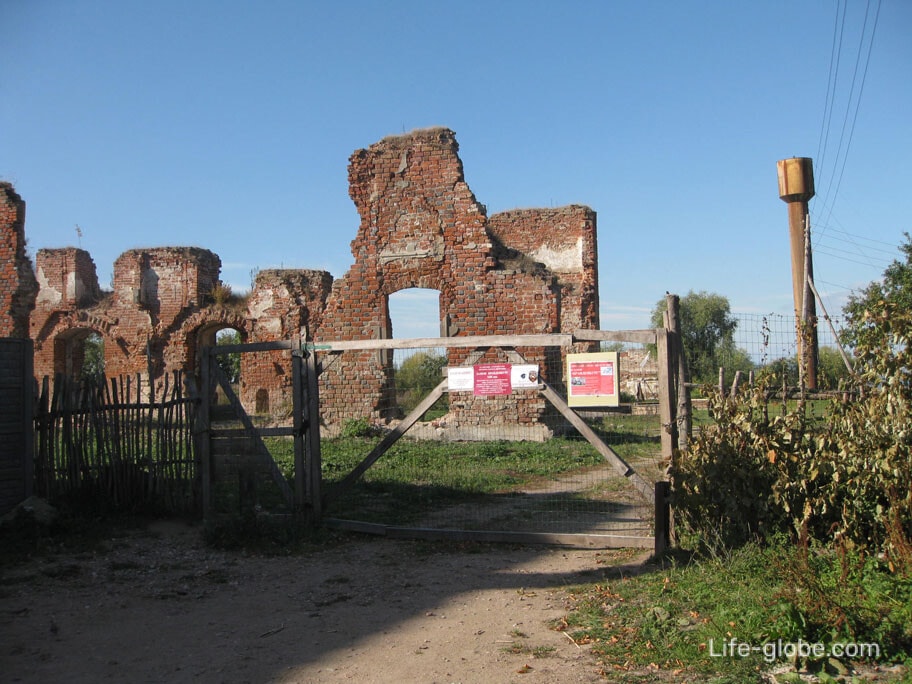
These signs at the entrance
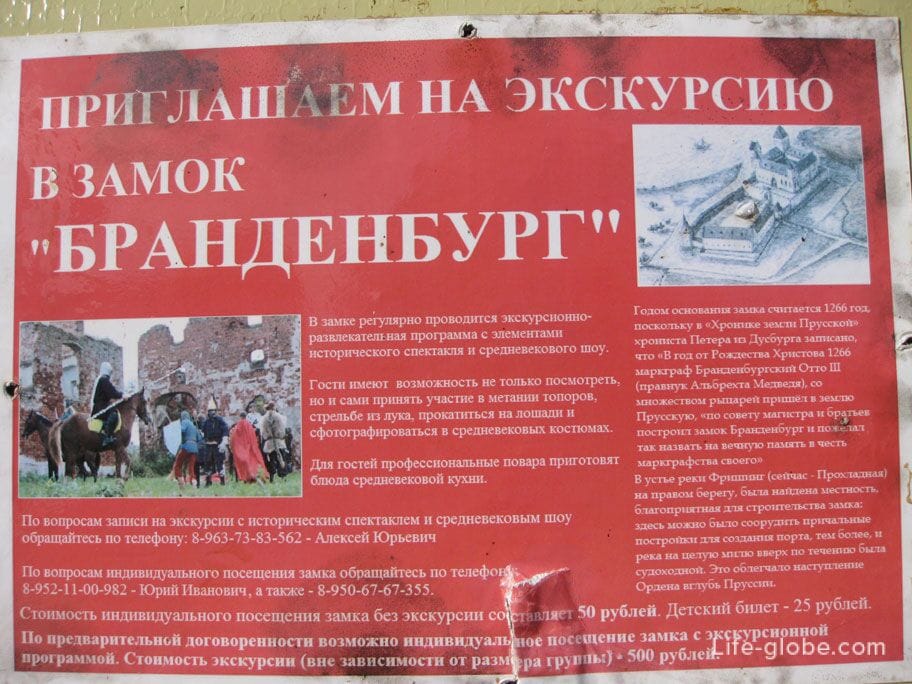

Naturally, neither of which the protection in fact the speech did not go. All of which is the protection of the castle, is a low rickety fence with breaches on the perimeter, come on, who wants, take what you fancy.
The ruins of the castle are in disrepair. On the territory of quietly grazing cows. All overgrown with grass and littered. The walls of the ruins slowly dismantled the bricks. It's easy to conclude that if so will go and further soon from the castle, nothing will happen, and in fact the ruins of a castle Brandenburg in 2007 received the status and to this day are the object of cultural heritage of regional value.
Needless to say that if these reinsurance machines were in Germany or Poland, then they would already have put in order, if not recreated the castle and ennobled all entertainment and tourist infrastructure near. And here we have this big problem. This is probably and so all is clear. Very sorry it's over, but let's not forget where we live.
Yet this state of Affairs in Russia is affected rather positively, all the more fueling and confirming the correctness of the decision of the move to relocate to Europe.
Back to the castle, here is what appeared in our eyes

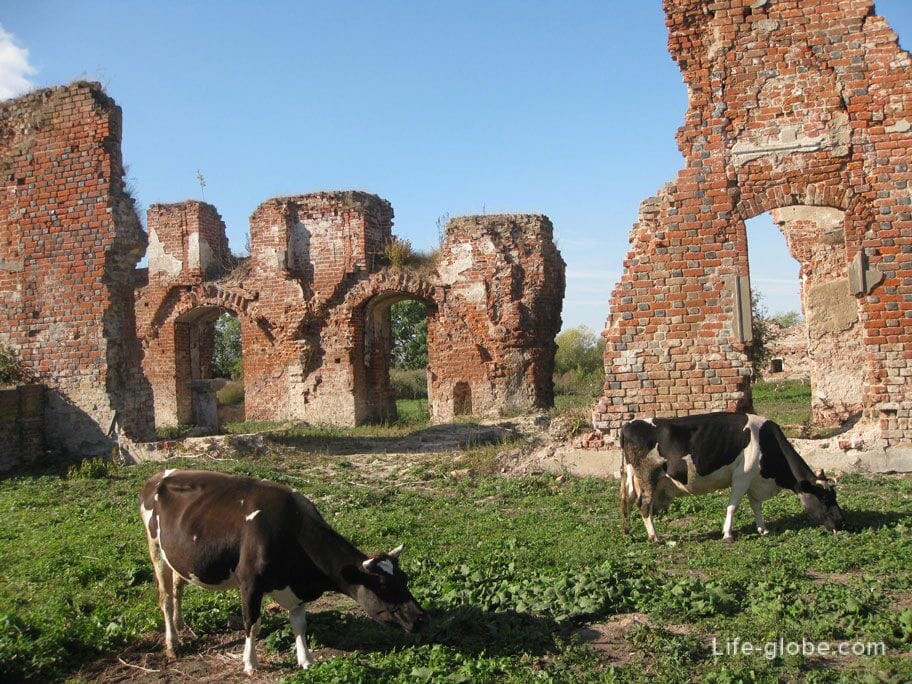


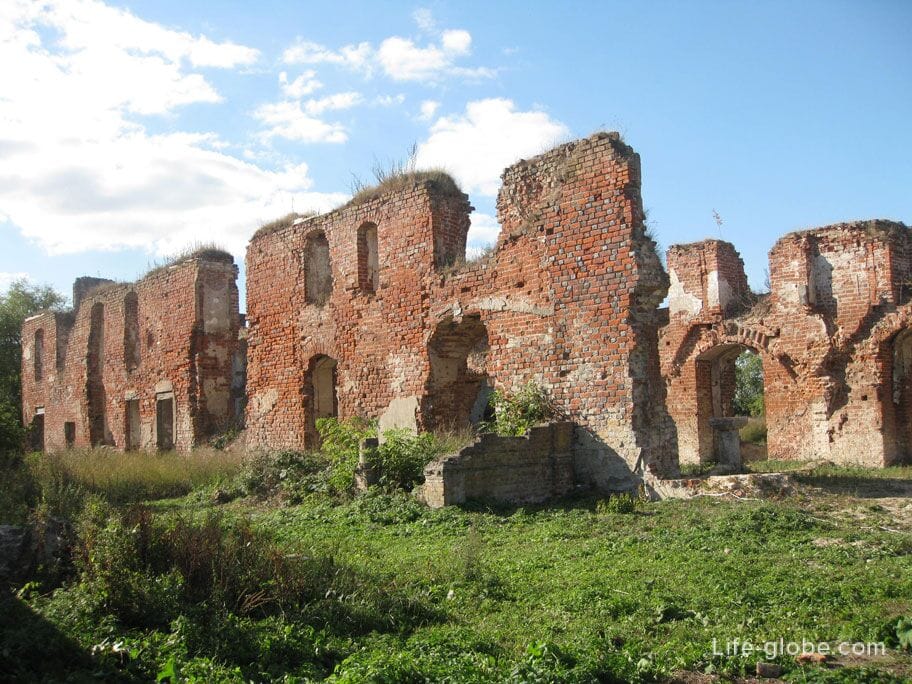
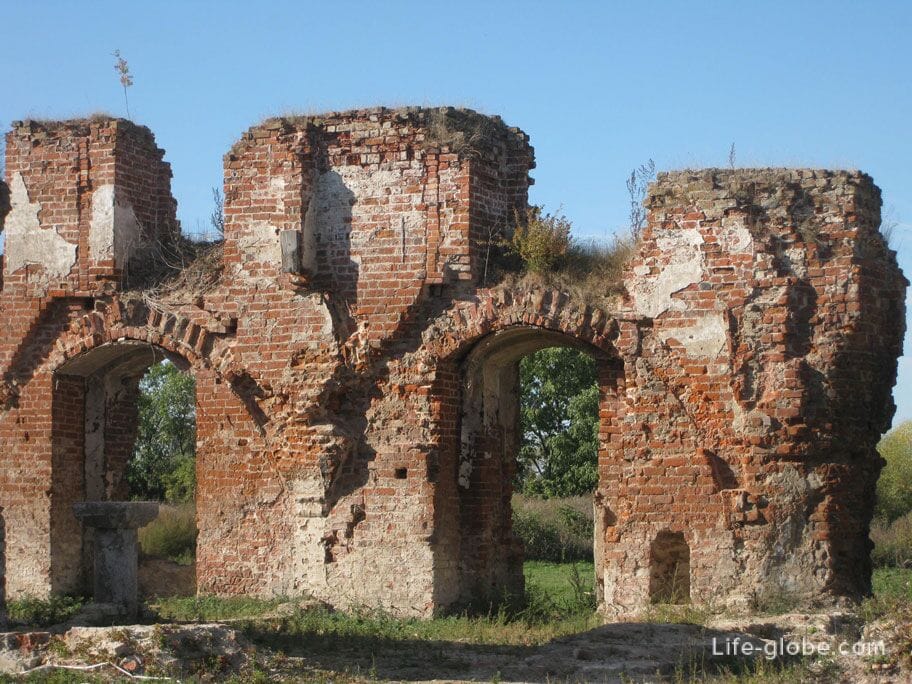
And finally, a few historical facts about the castle, for those interested in
The castle of Brandenburg was the Foundation in 1266. Here is what is mentioned about this fact in a "chronicle of the Prussian land" chronicler Peter of Dusburg: "In A. D. 1266, the Margrave of Brandenburg Otto III (great-grandson of Albrecht the Bear), with many knights came into the land of Prussia. On the advice of the master and brothers built the castle of Brandenburg, and wished to call on the eternal memory of in honor of the margraviate of his."
In the middle ages, throughout the history of the German order of castle Brandenburg was considered one of the most important kosturski locks. 1322 the castle was kept a relic: a fragment of the Holy cross on which Jesus was crucified. In 1379, the Emperor Charles IV gave the relic of Santa Catarina, exhibited in the chapel of the castle.
Later, under cover of the fortress formed a settlement inhabited by tradesmen like craftsmen, gardeners and fishermen. The settlement was called Brandenburg, but retained its original name until 1946, until the ground came into the possession of the Russians, and the settlement was not renamed in ushakovo.
In 1408 in the towns near the castle was opened the first school.
During a century of wars, 1454, 1456 and 1520 years the settlement near the castle was badly damaged by fire.
In modern times, 1525 the Grand master of the Teutonic order, Albrecht of Brandenburg (years of life 1490-1568 years) turned the Teutonic Order into the Duchy of Prussia.
In the XVI-XVII centuries, the Brandenburg became a fairly large settlement in which lived fishermen, gardeners, boatmen, cab drivers and small farmers. To 1604 in the village, there were already 7 restaurants and 50 yards.
Favorable location on a busy road in the Gulf and on the river contributed to the successful development of the settlement.
In 1652 Brandenburg was known as "the free place". In his time the king intended to give to the settlement even the status of a city, but it never happened.
In the nineteenth century, Brandenburg was designated as a "Magicpacket" - the village having the right to hold markets. At that time it was quite noble status of the settlement.
In 1817, a project was developed for a new road running directly across the swampy meadow. Along with the construction of the road was built and a new metal bridge. Later directly through the island formed by two arms of the river Fishing, dug a channel. The right sleeve of the river, held at the walls of the castle. Whereby the covered part of the left.
Its significance Brandenburg had lost after the construction of the Eastern railway, which took away from it.
With the beginning of the First world war in 1914, East Prussia became the scene of hostilities. In August 1914, Russian troops crossed the border and for a short time occupied a considerable part of the territory, however Brandenburg was not busy. The East Prussian operation ended badly for the Russians, then the Germans rallied and forced the Russian troops back.
In 1945 Brandenburg was in the area of fierce fighting and was partly destroyed.
After the Second World war, under the terms of the agreement at the Potsdam conference, Prussia was abolished as a state. East Prussia was divided between the Soviet Union and Poland. The Soviet Union withdrew one-third of Eastern Prussia with its capital Konigsberg, organizational included in the USSR as Kaliningrad oblast. At the same time the city of königsberg was renamed Kaliningrad.
Brandenburg in 1946 was renamed in ushakovo, received the status of the village. River Fishing got a Cool name. After minor repairs in the village lived several families of immigrants from the Soviet Union. The South-Western building of the castle that suffered the hardest during the war, it was not used, it staged several sheds, and in the middle of the former courtyard of forburg installed a small metal water tower, it has survived to this day, seen in the photos. Attached before the war to the Northern defensive wall of the building, which served as barns.
In 1964 the Commission of the Central scientific restoration workshops of the Ministry of culture of the USSR recommended to put a lock on the state record as a protected monument, but such work was not carried out.
In the early 1980-ies of the deteriorated part of the roof of Southeast wing. People began to settle, and since the beginning of 1990-ies the building was abandoned and the local population began to actively dismantle it for building materials, in just a few years turning the wing in ruins that we currently can observe. Unfortunately, informal analysis of the ruins of the castle on the bricks is carried out by local residents of the village ushakovo to this day.
In 2007, the ruins of the castle of Brandenburg gained the status of a cultural heritage object of regional importance.
In 2010, the Russian edition of Forbes magazine have included the castle of Brandenburg, in a list of six attractions in Russia under threat of extinction. The threat of extinction, as mentioned above, due to the fact, the Castle and located near the Church of Brandenburg, understand the locals for the bricks.
In 2013, the service of the state protection of objects of cultural heritage of the Kaliningrad region entered into an agreement with the Moscow firm "ART-Restoration" the restoration of the castle Brandenburg. However, the Moscow company to this day, only does that is developing a project of restoration of the castle, but this time his remains disappear.
For 2015 the castle is cleaned and restored, but the work is priochen very slowly. All due to the fact that the guys enthusiast is not enough money and people. Need volunteers and fans on mutually beneficial terms. If you are among those, any input would be invaluable.